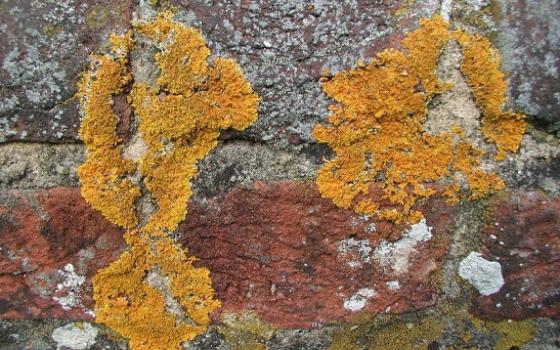I think a lot about fungi. Not just because I happen to think these not-plant and not-animal organisms are cool, but because they have so many things in common with religious life. Let me tell you about two of my favorite fungal friends.
First friend: lichens. Once, in a speech to sisters, I referred to lichens as a model of religious life. (In spite of their obvious misgivings, the sisters let me continue.) You have all seen them — the gray, greenish, or orangey crusts that coat bare rock, dead tree branches or even bare soil.
Lichens are actually two organisms living together in a cooperative venture. The fungus reaches out microscopic thread-like extensions, providing stability and soaking up water and nutrients. The green or yellow algae live embedded in the fungus, soaking up the sunshine and making food like any other green plant.
Cooperating like this gives lichens the ability to live on the margins, as so many sisters do. Because they are self-sufficient and require very little, lichens can thrive as a "pioneer" species, living where other things can't and creating soil and a place where moss and grass can become established later on. Then the lichen moves on to another bare rock or other marginal environment.
Have you noticed this about sisters? After successful careers in schools or hospitals, they almost always move back to the margins where they are needed, where civic and even official church institutions may not be willing to go.
Second friend: mycorrhizae. A more recently discovered function of fungi can be seen in forest ecology. For this friend, we have to look underground to see the fungi associated with plant roots.
Most of us think of a fungus as a mushroom-shaped thing, but the bulk of a fungus lives underground as a huge, web-like collection of connected microscopic threads. Far from being parasites that feed on and harm the plant, these fungal extensions of the plant's own roots help it absorb more water, collect more rare minerals, and make substances useful to the tree. They can even connect a "mama" tree with her nearby offspring, keeping her "aware of" their needs and helping her share needed water/nutrition with them in times of scarcity.
It turns out this huge underground network connects not just mama trees with baby trees, but almost all the trees in a forest, even different kinds of trees. And through this network of connections, many trees nurture each other, sounding the alarm for all when disease or pests attack, sharing scarce minerals, and making the whole forest into — in a way — one giant organism.
Given the charism of religious life as "collaboration," with which shall we compare ourselves, the fungus or the trees? Either analogy would work! We religious could be the underground network, connecting one area of need with another, connecting needy areas with resources, or supporting ministries and services. Or we are like the trees, going about our separate good works but connected by this wonderful underground supportive network of sharing and caring. Whichever you prefer — never wrinkle your nose at a fungus.
Let this be an example: Your reflection about religious life can start just about anywhere your imagination takes you. If you think you have a story or reflection, talk to Sr. Michele Morek at mmorek@ncronline.org or call 816-968-2232. Happy National Catholic Sisters Week!
[Ursuline Sr. Michele Morek is Global Sisters Report's liaison to U.S. sisters.]

